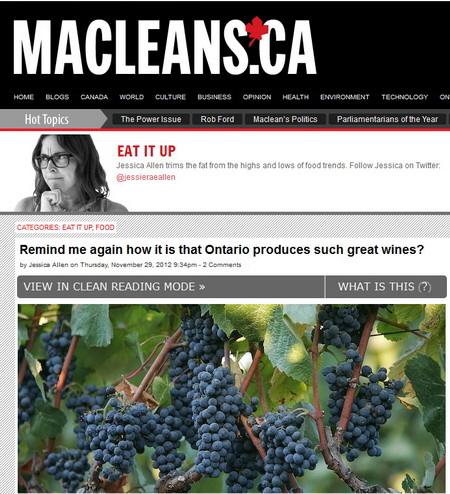This story about Ontario wines by Jessica Allen in Maclean’s Magazine deserves to be shared widely: she makes some excellent points about Ontario wines …
By I spent American Thanksgiving with friends in Washington D.C. They’re enthusiastic wine drinkers and the last time they visited this side of the border they couldn’t contain their excitement over a variety of Niagara wines they’d enjoyed. So, I brought along a couple to share.
They did not disappoint. But I did: when they asked me how it’s possible that cold Ontario could produce such standouts, I babbled on about Southern Ontario being on the same latitude as Northern California, so, you know, there’s that. Eyebrows were raised, and we all returned to our glasses of baco noir.
When award-winning wine writer Natalie MacLean published the winners of the Southern Ontario Sommelier Association’s awards for the best Ontario wines on her website recently, I reasoned that she’d be much better suited than I am to articulate how places such as Niagara, the North Shore of Lake Erie and Prince Edward County provide perfect terroirs for particular varietals.
There are a number of factors, says MacLean. ”First, Southern Ontario winemakers know more than ever about what works in their region. There was lots of experimentation in the early days, and some weird stuff that doesn’t work came out of that, but as you can see from the awards, Southern Ontario is just steller at riesling, pinot noir and cool-climate chardonnay—all the grapes that work well in a cool climate like ours do really, really well.”
And second, “Over time, you not only learn which grapes and wines work best for your soil and climate but you also perfect techniques and technology. In the restaurant industry you do stages. Well, wine makers from this wine region, espeically young ones, have gone out and worked in France, California and elsewhere and they come back and bring that expertise with them,” she says. “And similarly foreign winemeakers have come to Southern Ontario to learn and even to work here. So we’ve got a real exchange of expertise and a real improved use of technology and techniques that apply to this region specifically.”
The accolades for Ontario wines, of course, haven’t appeared overnight. They’ve been generated over time. “There’s more recognition of what’s going on in our own backyard, and it’s pretty spectacular.” But MacLean, who travels the world drinking and speaking about wine, still faces some international naïveté. ”The only reason why people abroad are not aware of the quality of Canadian wines is just because of the small quantity we produce,” she explains. “But small is great in wine! Small is a good thing! We’re never going to produce on a scale that’s going to be the Gallo of California, which is good.”
But we can compete with international wines. “For those in the inner circle who enter these coveted competitions, whether they’re in France or Italy,” says MacLean, “Canadian wines often come out on top in certain categories. There have been blind tastings where, for example, Le Clos Jordanne beat out nine or 10 other French Meursault Burgundies. We stand up and compete shoulder to shoulder with the world’s best wines.”
I had an eureka Ontario wine moment back in 2003 when I tasted a Stratus Red, an assemblage of a number of different grape varietals. It knocked my socks off. MacLean has a memorable moment too from about 12 years ago when she tasted her first dry red wine from Ontario, a pinot noir from Inniskillin, the winery that put Ontario ice wine on the map. “It blew me away. It was juicy and beautiful, but bone dry.”
The best part? “It was about $14 a bottle.”









I have been trying to buy Canadian wine (BC, Ontario,etc)
for many years. It is not only difficult, but impossible to do this in California.
For the wine education classes I teach at University of California-Irvine, I once had to get an IMPORT license to buy a bottle of Oculus from Mission Hill. Yes, we can get the stickies, but not dry wines.